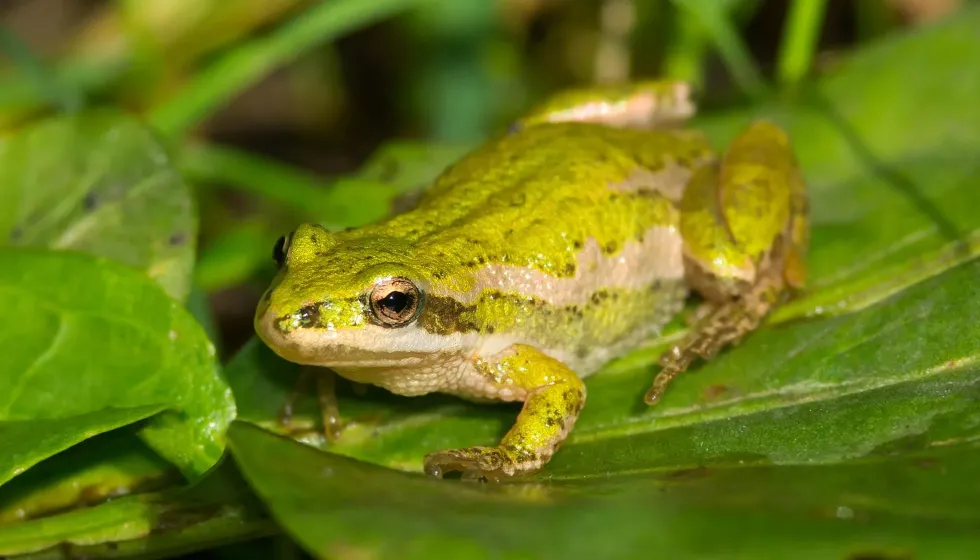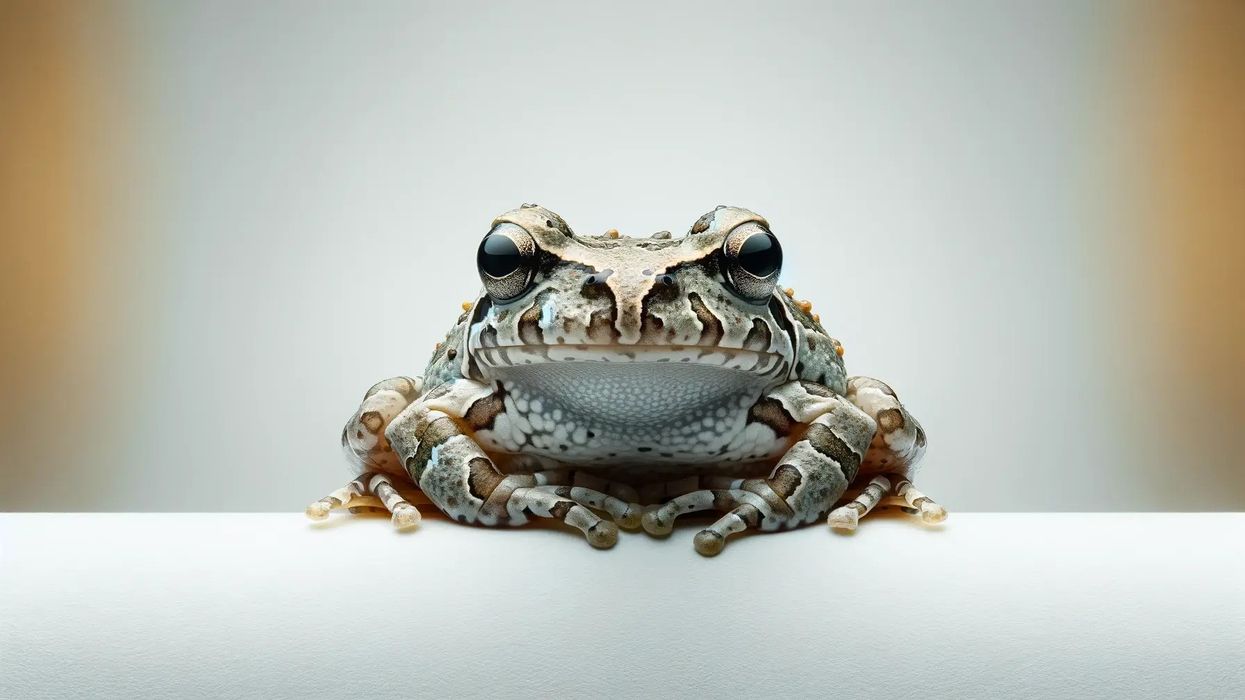The spotted chorus frog is a tree frog species endemic to the continent of North America. The spotted chorus frog's scientific name is Pseudacris clarkii.
The species is found in the countries of Mexico and the USA. In the USA, the spotted chorus frog range consists of the states of Oklahoma, Texas, and Kansas.
It is also found in Tamaulipas in Mexico. The 'spotted' in its name comes from the green spots or mottling on its back and the 'chorus' comes from the trilling call it makes during the breeding season. It lives for close to two years in the wild, mainly around grasslands, ponds, and prairies.
It feeds on insects and is preyed on by garter snakes and water snakes mainly. The spotted chorus frog species is known for the big congresses it forms around a pond or similar areas during the breeding season.
The IUCN status of the spotted chorus frog's population is Least Concern. This is one of the many chorus frog-amphibians and reptiles species that have stable population trends in North America.
For more great content, check out these Chinese giant salamander facts and tiger salamander facts for kids.
Spotted Chorus Frog Interesting Facts
What type of animal is a spotted chorus frog?
The spotted chorus frog (Pseudacris clarkii) is a tree frog.
What class of animal does a spotted chorus frog belong to?
The spotted chorus frog (Pseudacris clarkii) belongs to the Amphibia class of animals.
How many spotted chorus frogs are there in the world?
The exact number of spotted chorus frogs in the world is unknown, but their population trend is stable.
Where does a spotted chorus frog live?
The spotted chorus frog (Pseudacris clarkii) is endemic to the continent of North America, mainly the countries of America and Mexico. Its habitat range in America covers south-central parts, including Kansas in the north, Oklahoma to the south, and Texas.
Its habitat range in Mexico consists of Tamaulipas, in the valley of Rio Grande, and Matamoros. The spotted chorus frog habitat range also consists of northeastern New Mexico and the Gulf of Mexico.
What is a spotted chorus frog's habitat?
The spotted chorus frog species mainly lives in grassland habitats and prairies but they are found in a variety of different habitats. They like living in pastures, shrubland, meadows, lawns, and along the edges of woodlands. They are also seen near natural and artificial ponds, cattle tanks, and irrigation canals. Spotted chorus frogs go underground if inactive.
Who do spotted chorus frogs live with?
Spotted chorus frogs are solitary creatures apart from during the breeding season.
How long does a spotted chorus frog live?
Spotted chorus frogs live for at least two years in the wild.
How do they reproduce?
Spotted chorus frogs reproduce by mating and laying eggs. The breeding season is from January to June. The breeding site's pond is different from their home ponds, and males give out a 'pleading' call when near the breeding sites.
Breeding 'congresses' or 'choruses' are formed as a result of this call. The breeding habitat isn't just ponds, the spotted chorus frog species also uses marshes, ditches, buffalo wallows, transient pools, and flooded fields. These breeding ponds are used multiple times.
Eggs are deposited in loose masses of natural plant stems close to the water's surface. Close to 1,000 frog eggs are laid by females.
The larvae color varies greatly and a tadpole from clearer water tends to be darker than ones from muddy waters. Eggs and larvae come of age in breeding ponds or in pools of rain. Their larval stages last from 30-45 days.
What is their conservation status?
The conservation status of the spotted chorus frog (Pseudacris clarkii) according to the International Union for Conservation of Nature is Least Concern.
Spotted Chorus Frog Fun Facts
What do spotted chorus frogs look like?
Spotted chorus frogs are 1.2-1.6 in (3-4 cm) long and are an overall olive-green or gray color. They have mottling on their backs that is light green or dark green with black edges. Spotted chorus frogs have white undersides without any spots.
There is a green blotch between their eyes, in the form of a triangle. Males have dark throats during chorusing. They do not have a dark stripe on their backs like some other chorus frogs.

*Please note that this is an image of a Western chorus frog, not a spotted chorus frog. If you have an image of a spotted chorus frog, please let us know at hello@kidadl.com.
How cute are they?
Spotted chorus frogs are relatively cute animals and their tadpoles are super cute too! They are small creatures with a noticeable and high-pitched insect-like call. They are a cute gray color with green patches. They have adorable breeding and mating rituals where a lot of them gather around a pond to breed in droves when they hear a call.
How do they communicate?
The spotted chorus frog species communicates chiefly via a vocal call. They have vocal cords and amplifier sacs just like other frogs.
To make a call, air is forced backward by the sac and then forward between itself and the lungs to enable the vocal cords to vibrate and croak. During the breeding season, spotted chorus frogs give out a 'pleading' or 'pensive' call to attract females and males to form choruses around a pond.
Big choruses are formed after heavy rain in winter, early fall, and late spring.
After the call goes out and such choruses form, male spotted chorus frogs call at night with their bodies submerged in the water and only their heads looking out. You can hear these frogs day and night during the peak of their breeding season.
The call is a medium-pitched, loud, and repetitive 'whank, whank, whank'. If temperatures fall below 53.6 F (12 C), a grinding and slow note is used as a call instead.
How big is a spotted chorus frog?
Spotted chorus frogs are 1.2-1.6 in (3-4 cm) long, which makes them three to seven times smaller than the African bullfrog, seven to 10 times smaller than the goliath frog, and four to five times bigger than the Paedophryne amauensis.
How fast can a spotted chorus frog move?
Being a tree frog, the spotted chorus frog may be able to move at speeds of 10 mph (16.1 kph).
How much does a spotted chorus frog weigh?
A spotted chorus frog weighs 0.1-0.2 oz (3-4.2 g).
What are the male and female names of the species?
Males and females of the spotted chorus frog species do not have specific names.
What would you call a baby spotted chorus frog?
A baby spotted chorus frog is called a 'tadpole' or 'tadpoles'.
What do they eat?
Spotted chorus frogs eat insects, flies, crickets, ants, moths, beetles, and plants.
Although no extensive data is available on their predators, spotted chorus frogs may have leeches, insects, salamanders, fish, birds, snakes, and other mammals as predators. Western ribbon snakes, garter snakes, and water snakes are known predators of the spotted chorus frog.
Are they poisonous?
No, spotted chorus frogs are not poisonous at all.
Would they make a good pet?
Spotted chorus frogs are not very popularly taken as pets. They are a wild species of amphibians that thrive in the wild and have elaborate and entertaining rituals.
Their natural history is built around natural habitats. So instead of taking them as pets, efforts should be taken to address declines in local populations of the spotted chorus frog in their American and Mexican habitats.
Did you know...
A related species, the Boreal chorus frog (Pseudacris maculata) is capable of learning defensive tactics from other species that have the same predators.
Boreal chorus frogs have three dark stripes on their backs and one dark stripe through their eyes. When looking them up in any field guide, boreal chorus frogs are found to be 11.8 in (30 cm) long, which is slightly smaller than the average spotted chorus frog size.
Boreal chorus frogs are endemic to the grasslands and cleared forests of Canada and they eat mostly insects and spiders.
The spotted chorus frog has another common name: Clark's tree frog. Nother type of frog also has another common name: the western chorus frog is also known as the striped chorus frog.
The western chorus frog is the same size as the spotted chorus frog. The western chorus frog has a wider distribution range and the western chorus frog is also nocturnal.
Reptiles and amphibians worldwide are facing a general decline in populations due to a loss of habitats, hunting, the pet industry, and global climate change.
Most chorus frogs prefer marshes, woodlands, forests as habitats. Like most frogs, chorus frogs may jump about 20 times their length, which is 1.5-5.5 in (3.8-14 cm)!
Different types of chorus frog
There are close to 19 different species of chorus frogs although these are disputed because of the similar behavior, common geographic range, and frequent hybridization between frogs. All of them exist in their natural habitats of the North American continent. Their name comes from the repetitive, trilling call that resembles the sound made by insects.
Some chorus frogs include the Appalachian mountain chorus frog, Brimley's chorus frog, the California tree frog, the spotted chorus frog, Collinses’ mountain chorus frog, the spring peeper, the upland chorus frog, the Cajun chorus frog, the Baja chorus frog, the Illinois chorus frog, the New Jersey chorus frog, the boreal chorus frog (Pseudacris maculata), the southern chorus frog, the little grass frog, the ornate chorus frog, the Pacific tree frog, the Sierran chorus frog, Strecker's chorus frog, the western chorus frog (Pseudacris triseriata) or the striped chorus frog, and the Javan chorus frog.
All chorus frogs belong to the Pseudacris genus except the Javan chorus frog which belongs to the Microhyla genus.
All chorus frogs also hold the status of Least Concern under the IUCN, except Collinses' mountain chorus frog, the Baja chorus frog, the Illinois chorus frog, and the Sierran chorus frog, which are not evaluated.
Of the species whose status has been evaluated, all of them have stable populations across North America, except the Appalachian mountain chorus frog and Strecker's chorus frog whose population trends are unknown.
The western chorus frog is the only one to show a declining population trend.
Do spotted chorus frogs bite?
No, spotted chorus frogs are not known for biting. There are only three frog species that may bite and those are African bullfrogs, Budgette's frog, and Pacman frogs.
Here at Kidadl, we have carefully created lots of interesting family-friendly animal facts for everyone to discover! Learn more about some other amphibians from our olm surprising facts and bullfrog fun facts pages.
You can even occupy yourself at home by coloring in one of our American bullfrog coloring pages.
*Please note that this is an image of an Illinois chorus frog, not a spotted chorus frog. If you have an image of a spotted chorus frog, please let us know at hello@kidadl.com.









